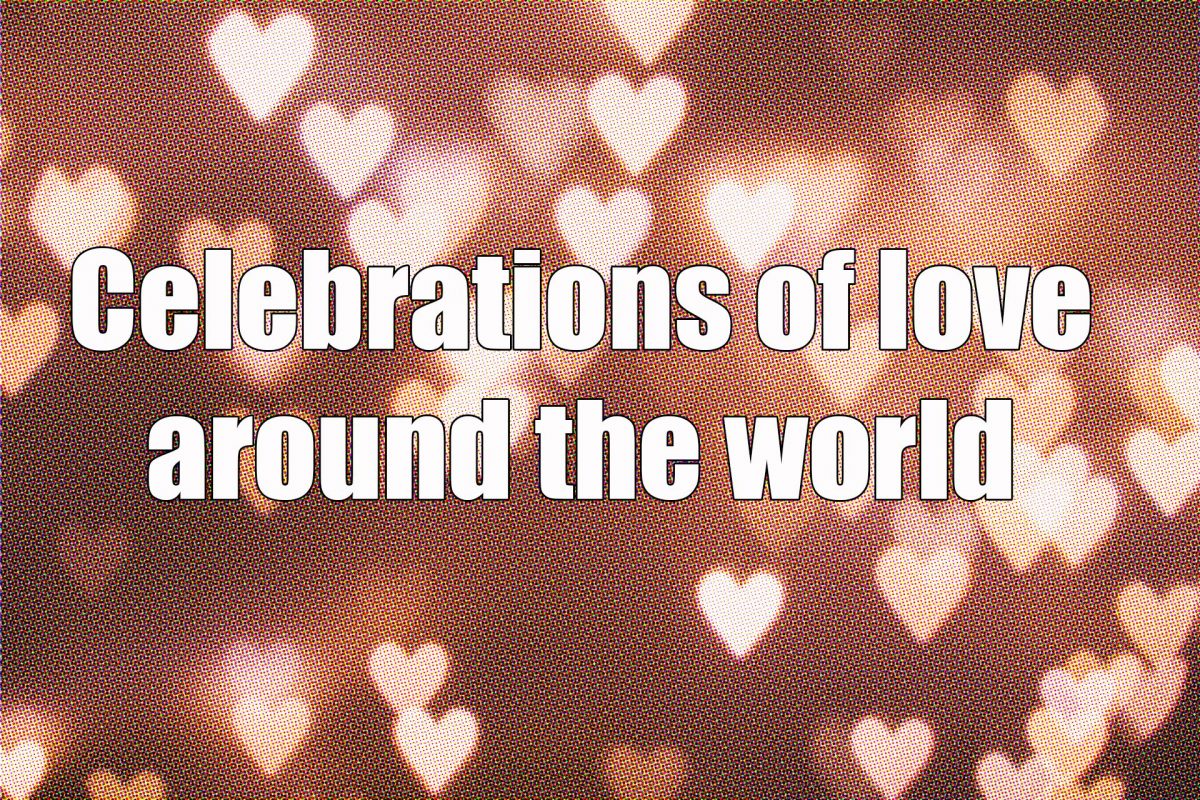
(*Linked or embedded content may have been removed or be unavailable.)
Now that Valentine’s has come and gone again, it’s time to consider what it was all about. Why are people celebrating that day? What tradition does it stem from? Perhaps a bit of Christian tradition, since after all, St. Valentine is a Catholic saint? Or, more likely, based on a more recent tradition of commercialization. In this post, we’ll take a look at how folks in different countries deal with Valentine’s Day and beyond.
So, what’s the origin of Valentine’s Day and why do we celebrate it? Fact of the matter is, the origins are not clear cut. According to Wikipedia, “There are a number of martyrdom stories associated with various Saint Valentines connected to February 14, including an account of the imprisonment of Saint Valentine of Rome for ministering to Christians persecuted under the Roman Empire in the third century. According to an early tradition, Saint Valentine restored sight to the blind daughter of his jailer. Numerous later additions to the legend have better related it to the theme of love: tradition maintains that Saint Valentine performed weddings for Christian soldiers who were forbidden to marry by the Roman emperor; an 18th-century embellishment to the legend claims he wrote the jailer’s daughter a letter signed ‘Your Valentine’ as a farewell before his execution.”
But whether Valentine’s Day comes from the Roman priest executed on February 14, 270 CE is unclear. Records document at least three Saint Valentines, all martyred around the 3rd century CE, including the Bishop of Terni. Most information about Saint Valentine comes from legends and hagiographies written centuries after his death, lacking historical accuracy and often blending details from different individuals. Also, we cannot discount the prospect that Valentine’s Day was heavily influenced by Lupercalia, an ancient Roman festival celebrating fertility and purification between young men and women, that pre-existed from long before this time.
Between Valentinus (that would be his Roman name) being martyred in the 3rd century, and today, the Middle Ages saw Valentine’s Day become associated with courtly love and the exchanging of handwritten love notes. By the 18th century, England saw the rise of commercially produced Valentine’s cards and gift-giving traditions (yup, commercialization had already kicked in way back then), and in the 19th and 20th centuries Valentine’s Day took its place among the yearly celebrations as a major commercial event for expressing romantic love, as well as love for friends and family through expressions of appreciation and affection.
Contents
Valentine’s in North America
In the United States and Canada, the classic Valentine’s Day scene prevails, with exchanging cards, flowers, chocolates, and romantic dinners being the most common expressions of love. Children make their first handcrafted items in kindergarten and grade school, involving cutting heart shapes out of red paper, and have fun exchanging not-so-gourmet heart-shaped candies with their friends. Hallmark cards reign supreme, and red roses dominate the floral landscape. As a new twist on old tradition, some celebrate “Galentine’s Day” to appreciate female friendships.
Valentine’s in Latin America
Throughout Spanish-speaking Latin America, Valentine’s Day is celebrated either as Día de los Enamorados (Lovers’ Day) with an emphasis on romantic love, or Día del Amor y la Amistad (Day of Love and Friendship) which focuses on both romantic and platonic love. Couples enjoy romantic outings, while friends exchange tokens of friendship. Red roses hold significance, and pan dulce (sweet bread) shaped like hearts is a popular treat. In some regions, men serenade women with traditional music in a way that harkens back to Spanish roots. In Guatemala, their “Old Love Parade” features seniors showcasing their enduring love through vibrant costumes and dances.
Celebrated on the 12th of June instead of February, Brazilians hold their Dia dos Namorados (Lovers’ Day) with couples enjoying romantic gestures, gifts, and outings. Red roses and chocolates are popular gift items. Sometimes there is a mixed celebration with Saint Anthony’s Day that comes on June 13, celebrated primarily by single women seeking love. And further south in Argentina, their Día de los Enamorados on February 14 focuses on romantic gestures, while Semana de la Dulzura (Sweet Week) in July encourages exchanging sweets as expressions of affection.
Valentine’s in Europe
In France, Valentine’s celebrations are traditionally focused on La fête des amoureux (Lovers’ Festival) with passionate declarations, red roses, and romantic dinners. And their une loterie d’amour (Lottery of Love) was a historical practice where singles were paired up randomly, much like the Romans did during Lupercalia. The French government eventually outlawed this lottery so it’s one of the more interesting parts of Valentine history rather than the current reality.
Italy features a day for sweet gestures like exchanging baci perugina (chocolate kisses) and enjoying candlelit dinners. In Germany, the focus is on red roses, marzipan hearts, and candlelit dinners. In some regions, men give chimney sweep figurines for good luck in love. In Spain, they celebrate with romantic dinners, red roses, and exchanging gifts like chocolates and flowers. The Catalonia region of Spain celebrates Sant Jordi on April 23, where men traditionally give roses and women reciprocate with books.
The Scandinavians also have their own thing going. Sweden celebrates doubly, with cards, flowers, and sweets on Vänskapens Dag (Friends’ Day) on February 14, and on Alla Hjärtans Dag (All Hearts’ Day) on the following Saturday, to allow for the celebration of both friendship and romantic love. In Denmark, men traditionally send Gaekkebrev (anonymous love letters) to women, who respond later with an Easter egg. And in Finland, they traditionally celebrate Ystävänpäivä (Friend’s Day), focusing on expressing friendship and appreciation with cards and small gifts, not just romantic love.
Valentine’s in Asia
The half-Filipino comedian Jo Koy described the Philippines as “the Mexico of Asia,” and the cultural influence of Spain on this Asian nation is quite clear even in the way they celebrate Valentine’s Day – including Harana, which is a serenading tradition where men sing love songs outside their love interest’s window, accompanied by a guitar. Filipinos also shower their loved ones with gifts like chocolates, flowers and teddy bears.
Japan and Korea share similar, heavily commercialized Valentine traditions that focus on women expressing affection to men. Japanese women have special names for their chocolates to differentiate between the honmei choco (true feelings chocolate) that goes to romantic interests, and giri choco (obligation chocolate) that goes to friends, colleagues and bosses. Men reciprocate on White Day (March 14), when men gift women with something white, like white chocolate. And the same is true for Korea, except they go even a step further with Black Day (April 14) on which singles “celebrate” their self-reliance by eating jajangmyeon black noodles.

ASAP: A White Day display goes up in a Tokyo supermarket one day after Valentine’s
In China, Valentine’s is not much of a thing. Instead, love is celebrated during the Qixi Festival (七夕) that occurs on the 7th day of the 7th lunar month, falling sometime between July and September. This festival celebrates the love story of the Cowherd (Altair) and the Weaver Girl (Vega), separated by the Milky Way but reunited once a year. Japan’s equivalent to Qixi is called the Tanabata Festival (七夕), celebrated only July 7 separately from Valentine’s Day. On the island of Taiwan, where western culture is more widely embraced especially in urban areas, couples exchange gifts, enjoy romantic outings, and visit temples associated with love and matchmaking on Valentine’s Day as well.
Perhaps one takeaway you might be gleaning from this post is that Valentine’s is way too commercialized. But is that necessarily a bad thing? Commercialization not only helps more people celebrate Valentine’s in more ways, but also helps support families that manufacture and sell the goods that make Valentine’s an event that has far outgrown its religious roots. It’s like pay-forwarding the love, on a grand scale. And no matter how commercialized it gets, that heart-shaped paper thingy that the kids bring back from kindergarten or grade school for Valentine’s will always rank highest on the priceless-ness scale.
Many countries all over the world celebrate Valentine’s Day, but with different interpretations, different nuances, and different levels of commitment. Because nothing in the world is truly one-size-fits-all. Everything needs to adjust and adapt to the environment it’s put in or it gets discarded, and this particular day for celebrating love is no exception.
As I mention the word “celebrate” for the nth time in this post, the one thing that’s certain about the human species is our need to celebrate and share the joy. Just like we might celebrate a team’s winning a tournament, a candidate winning an election, or a ticket winning a lottery, it doesn’t take much to imagine our prehistoric ancestors celebrating the downing of a woolly mammoth. It’s all in our DNA.
So if you have content you would like to share with the world, make sure you localize it in a way that’s culturally suitable and fitting for your target market. Rely on experts to make your localization effort a cause for celebration.
Douglass McGowan






